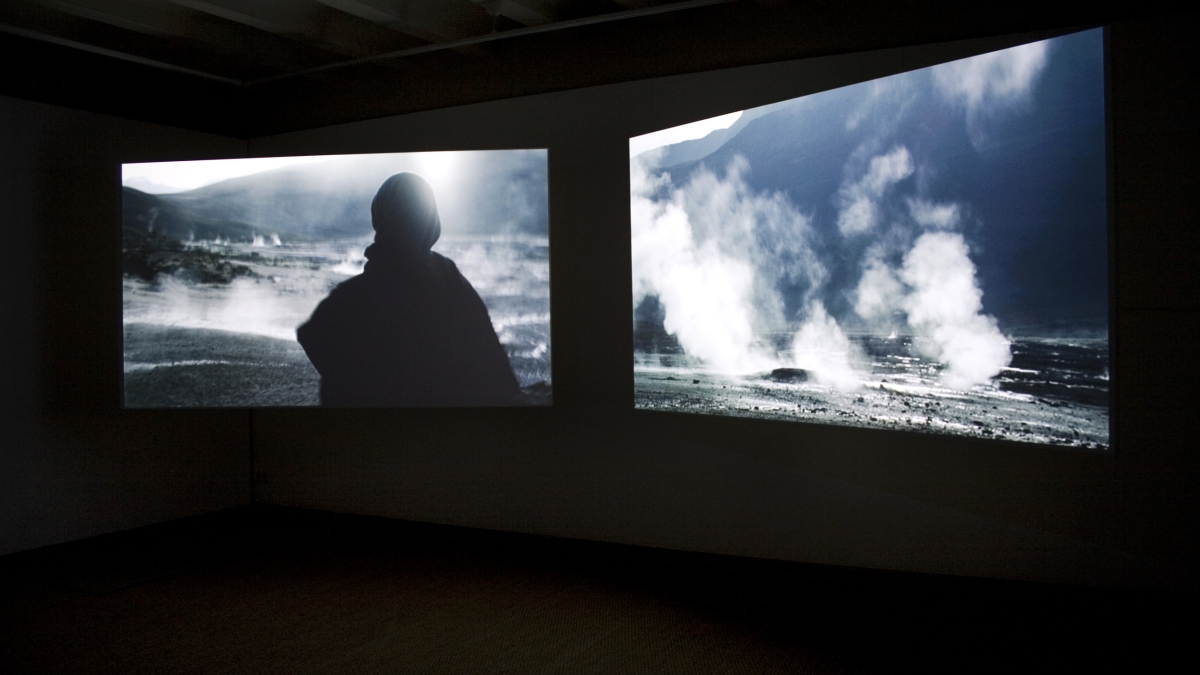'Shifting Sands' video exhibit explores zones of conflict in Middle East

The ASU Art Museum is pleased to present the work of four international artists using film and video in the exhibition “Shifting Sands: Recent Videos from the Middle East,” on view through Nov. 29, in the Turk and Kresge Galleries at the museum’s 10th Street and Mill Avenue location.
“Shifting Sands” features the art of Lida Abdul (Afghanistan), Yael Bartana (Germany/Israel), Emily Jacir (Palestine/Italy) and Isabel Rocamora (Spain/U.K.),* and explores zones of conflict, including the Israel-Palestine border and Afghanistan, with a focus on the shifting personal, political and geographical landscapes of the Middle East.
Organized and first presented in 2012 at the Stanlee and Gerald Rubin Center for the Visual Arts at The University of Texas at El Paso in conjunction with Desert One, a regional, collaborative project involving a network of institutions initiated by the Desert Initiative at the ASU Art Museum, “Shifting Sands” was co-curated by Kate Bonansinga and Kerry Doyle. The ASU Art Museum presentation of the exhibition is managed by Heather Sealy Lineberry and is supported by the Helme Prinzen Endowment and the ASU Art Museum Creative Impact Board.
“After Desert One, we approached the curators at the Rubin Center about presenting ‘Shifting Sands’ here at the ASU Art Museum, and we are pleased to be the only other venue,” says Lineberry, who serves as the associate director and senior curator at the ASU Art Museum. “We were taken with the exhibition’s focus on desert landscapes in the Middle East and the impressive selection of internationally known and exhibited artists.”
Featuring six video works by four different artists, "'Shifting Sands' not only gives audiences exposure to excellent contemporary art being produced in and about the Middle East, but also serves as a dynamic catalyst for dialogue about culture, politics and current events in the region,” explains Doyle, director of the Stanlee and Gerald Rubin Center for the Visual Arts.
“Beginning in the early 1990s, the ASU Art Museum was the first institution in Arizona to exhibit and collect video and new media art,” says Lineberry. “‘Shifting Sands’ continues this emphasis on, arguably, the most influential medium in contemporary art. The artists in the exhibition utilize video for its range of potential, and the exhibition includes works that take the form of complex narratives, dance for the camera, and abstract and poetic vignettes.”
A 27-page, full-color publication, “Shifting Sands: Recent Videos from The Middle East,” accompanies the exhibition. It was published by the Stanlee and Gerald Rubin Center for the Visual Arts in 2012 with the support of the Texas Commission on the Arts and the Patricia Hewitt Silence Memorial Fund, and features essays by Kate Bonansinga, Noah Simblist and Kerry Doyle, as well as an exhibition checklist and artist biographies. Copies will be available for purchase in the ASU Art Museum Store for the duration of the exhibition.
A reception for the exhibition will be held from 6:30 to 8:30 p.m., Oct. 2 (with a members, alumni and press preview from 5:30 to 6:30 p.m.).
Two other events will be held in conjunction with the exhibit:
“Civility in Action, Part I”
6-8 p.m., Sept. 9, ASU Art Museum
A series of Valley-wide citizen dialogues on election issues, “Civility in Action” is designed to foster civility. Hosted by the Institute for Civil Dialogue in association with the Hugh Downs School of Human Communication at ASU, it provides a structured format for public dialogue as a tool to build bridges across the chasm of public viewpoints. This conversation in the series will be set against the backdrop of the “Shifting Sands” exhibition and consider political issues and the Middle East.
“Dancing in Jaffa,” film screening and discussion
7 p.m., Oct. 30, ASU Physical Education Building East, room 132
"Dancing in Jaffa" is a compelling new documentary about ballroom dancing as a means of bridging differences between Jewish and Muslim children. This screening, presented in conjunction with “Shifting Sands” at the ASU Art Museum, is co-sponsored by the Center for Jewish Studies, the Center for the Study of Religion and Conflict, the ASU School of Film, Dance and Theatre, and the Herberger Institute for Design and the Arts Socially Engaged Practice Program.
All ASU Art Museum events are free and open to the public.
The ASU Art Museum is open 11 a.m. to 8 p.m., Tuesdays (during the academic year), and 11 a.m. to 5 p.m., Wednesday through Saturday. The museum is closed on Sundays and Mondays. To learn more about the museum, call 480-965-2787, or visit asuartmuseum.asu.edu.
*To read the artists' full bios, visit asuartmuseum.asu.edu/news/press_release.php?id=1060.